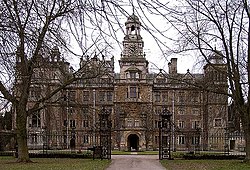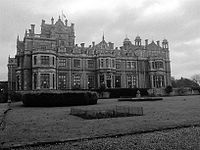Thoresby Hall
| Thoresby Hall | |
| Nottinghamshire | |
|---|---|
 Thoresby Hall | |
| Location | |
| Grid reference: | SK63837116 |
| Location: | 53°14’1"N, 1°2’43"W |
| Village: | Budby |
| History | |
| Built 1864 – 1871 | |
| For: | Sydney Pierrepont, 3rd Earl Manvers by Anthony Salvin |
| Country house | |
| Information | |
| Condition: | Converted to a hotel |
| Owned by: | Warner Leisure Hotels |
Thoresby Hall is a 19th-century country house in Budby, Nottinghamshire, some two miles north of Ollerton. It is one of four neighbouring country houses and estates in the Dukeries in the north of the county, all occupied by dukes at one time during their history.
The hall is constructed of rock-faced ashlar with ashlar dressings. It is built in four storeys with a square floor plan surrounding a central courtyard, nine bays wide and eight bays deep, and it is a Grade I listed building.[1]
History
Robert Pierrepont, 1st Earl of Kingston-upon-Hull acquired the Thoresby lands in 1633, but was killed in the Civil War in 1643.[2] His son Henry Pierrepont, the 2nd Earl, built the first grand house, attributed to the architect Talman, about 1670.[2] The house was remodelled for William Pierrepont, the 4th Earl, during 1685–87, probably by Benjamin Jackson, after the earl had been granted the right in 1683 to create the park by enclosure from Sherwood Forest.[1] The house was the birthplace in 1689 of Lady Mary Pierrepont, wife of the diplomat Edward Wortley Montagu.[3]
The estate passed to Evelyn Pierrepont, 2nd Duke of Kingston-upon-Hull (1711–1773), who fought at the Battle of Culloden in 1746 but the house was destroyed by fire that same year. Twenty years later the architect John Carr during 1767–1772 built a new house on the same site.[1] Humphry Repton landscaped the park at the same time.[2]
When the 2nd Duke died in 1773 he left the estate to his wife, Elizabeth Chudleigh. However after a scandalous trial in the House of Lords, she was declared to have married the Duke bigamously, as she had previously married the Earl of Bristol ('the English Casanova'); thus she was obliged to surrender the property on her death in 1786 to the duke's nephew, Charles Medows, a Royal Navy officer. He adopted the name Pierrepont and later became the 1st Earl Manvers.[3]
In 1868, Sydney Pierrepont, the 3rd Earl Manvers, commissioned the celebrated country house architect Anthony Salvin to demolish the house after just a hundred years and replace it with the present house, erected 600 yards to the north. Completed in 1871, it measures 180 feet on its east and south fronts and 157 feet on its west front. The impressive Great Hall, with minstrels' gallery at the west end, is 60 feet long and 45 feet high.
The house descended to Gervas Pierrepont, 6th Earl Manvers who died in 1955 without a male heir and the title thereby became extinct. The house remained with his wife, Countess Manvers, and their daughter Lady Rozelle Raynes.[4]
To minimise a perceived threat from coal mining subsidence the buildings were sold to the National Coal Board in 1979 and sold on the open market ten years later. In 2020 these fears came to light when abandoned mine workings subsided below the property, which required repairs from the Coal Authority.[5] The core of the Thoresby furniture collection was retained by the family who built a new house on the other side of the lake, while the remainder was sold at auction by Sotheby's in 1989. After a number of owners it was acquired by Warner Leisure Hotels.[3] The 90,416.8-square foot (8,400.0-m²) Salvin house had a new bedroom wing added before opening as a 200-room country house hotel with spa facilities in 2000.[3]
The Queen's Royal Lancers and Nottinghamshire Yeomanry Museum[6] occupies part of the courtyard which is now open to the public as a retail space.[7]
Outside links
| ("Wikimedia Commons" has material about Thoresby Hall) |
- History from Worksop Heritage Trail
- Nottinghamshire History:
- Warner Breaks: Thoresby Manor
- What's On at Thoresby
References
- ↑ 1.0 1.1 1.2 National Heritage List 1045449: Thoresby Hall and adjoining outbuildings, gate and railings (Grade I listing)
- ↑ 2.0 2.1 2.2 National Heritage List 1000361: Thoresby Park (Register of Historic Parks and Gardens)
- ↑ 3.0 3.1 3.2 3.3 "Thoresby". http://www.worksopheritagetrail.org.uk/resources/thoresby_history.pdf. Retrieved 26 March 2013.
- ↑ "Cliffe Castle Park Conservation Group". http://www.cliffecastlepark.org.uk/morehistory.html. Retrieved 15 March 2018.
- ↑ "Coal Authority". Coal Authority repairs grade I listed hotel in Nottinghamshire. https://www.gov.uk/government/news/coal-authority-repairs-grade-i-listed-hotel-in-nottinghamshire?utm_source=twitter&utm_medium=social&utm_campaign=coalauthority&utm_content=230720Thoresby. Retrieved 23 July 2020.
- ↑ "Charge of the Light Brigade bugle stars at new museum". BBC. 26 July 2011. https://www.bbc.co.uk/news/uk-england-nottinghamshire-14295666. Retrieved 5 June 2018.
- ↑ "Shopping". What's on at Thoresby. http://whatsonatthoresby.co.uk/plan-your-visit/shopping/. Retrieved 9 April 2020.
| Noble seats of The Dukeries in Nottinghamshire |
|---|
|
Clumber Park • Rufford Abbey • Thoresby Hall • Welbeck Abbey • Worksop Manor • Welbeck Woodhouse |
